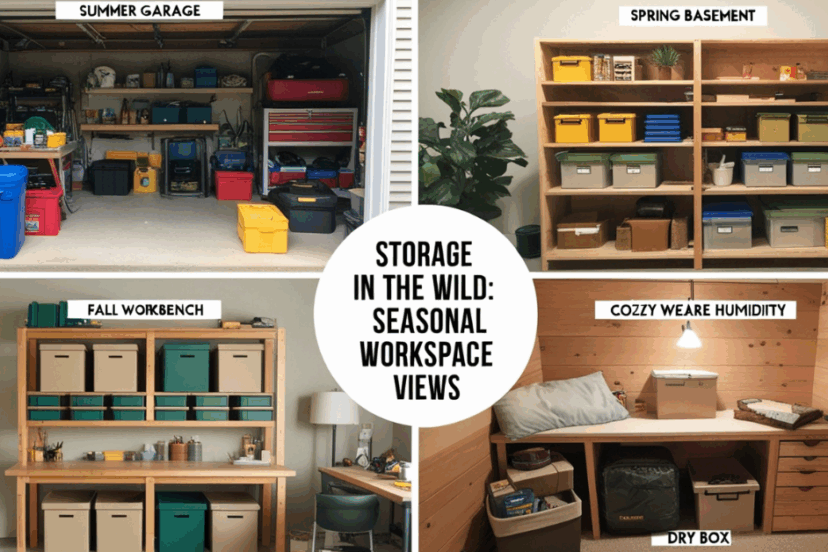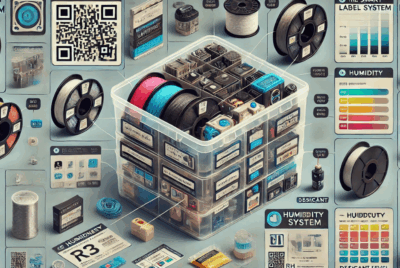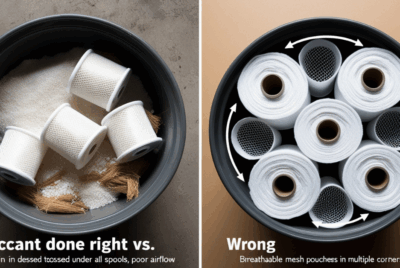How Does Filament Storage Change in Different Seasons?
1. Your Filament Has Seasonal Allergies
Just like you might reach for allergy meds in the spring or extra layers in winter, your filament has its own seasonal sensitivities.
Humidity spikes, dry air, temperature swings—each season brings its own set of filament storage challenges.
Let’s walk through how to adapt your storage game year-round.
2. Why Seasonal Changes Matter for 3D Printing Filament
Filament is hygroscopic, meaning it loves to absorb moisture from the air.
But it’s not just humidity—it’s:
- Sudden temperature drops
- Heating systems and AC cycles
- Airflow changes
- Condensation from overnight swings
Each season impacts your filament differently.
3. Spring: The Silent Moisture Creeper
Spring may feel pleasant, but it’s deceptively damp.
What to watch for:
- Rising humidity from rain
- Melting snow in basements and garages
- Poor airflow from closed windows
- Moldy, stale air in closed containers
Spring tip: Check RH daily and refresh your desiccant more often.
4. Summer: Heat, Humidity, and Storage Stress
Summer is filament’s moisture nightmare—especially in non-AC rooms.
What can go wrong?
- RH can hit 70%+
- Warm air accelerates absorption
- Seals on storage bins may loosen from heat
- Filament can soften or warp if near windows
Summer tip: Move storage to the coolest room, avoid attic/garage setups, and run a dehumidifier if possible.
5. Fall: The Underrated Filament Killer
Fall feels mild, but it’s full of air instability.
Why?
- Cold nights + warm days = condensation inside bins
- Heaters turn on, changing airflow
- Damp leaves or increased rain affect garage setups
Fall tip: Watch for spikes in humidity at night and store in containers with double gaskets or extra seal support.
6. Winter: Dry Air or Condensation Trap?
Winter usually brings dry indoor air—great, right? Not always.
Problems to expect:
- Super dry rooms = brittle PLA
- Big temp swings between inside and outside can cause condensation when spools move rooms
- Basement cold + indoor heat = condensation inside storage bins
Winter tip: Keep storage in climate-stable rooms and don’t move filament suddenly from cold to warm.
7. How Temperature Swings Impact Sealed Spools
Temperature changes = pressure changes.
That can mean:
- Vacuum-sealed bags losing suction
- Air pulled into storage boxes through microgaps
- Condensation inside containers
Let spools acclimate slowly before opening sealed containers—especially in winter or fall.
8. Seasonal Moisture vs. Material Type
Some filaments are more vulnerable during certain seasons.
| Filament | Season Most at Risk | Why |
|---|---|---|
| Nylon | Summer | Soaks moisture rapidly |
| TPU | Spring | Moist air = stringing |
| PLA | Winter | Can dry out and become brittle |
| PETG | Fall | Sensitive to temp changes |
| PVA | All | Absorbs moisture fast year-round |
Know your material, then adjust storage accordingly.
9. How to Adapt Your Storage Setup Each Season
| Season | Key Action |
|---|---|
| Spring | Replace silica often |
| Summer | Keep filhttps://3dprinttrend.com/store-filament-in-original-packaging/ament cool & sealed |
| Fall | Use insulated storage & track RH |
| Winter | Avoid sudden temp changes |
Rotate desiccants and monitor containers weekly. Even well-sealed storage can get compromised.
10. Tools That Help All Year Round
✅ Color-changing silica gel
✅ Humidity cards or Bluetooth sensors
✅ Gasket-sealed bins
✅ Vacuum bags for long-term storage
✅ Dehumidifier for garage or basement setups
✅ Thermal storage sleeves for unconditioned spaces
These tools stay relevant no matter what season you’re in.
11. Best Practices for Spring Storage
- Elevate bins off cold basement floors
- Keep windows closed when humidity spikes
- Check for mold buildup in containers
- Add extra silica packs to bins
12. Best Practices for Summer Storage
- Store filament in AC-controlled rooms
- Avoid direct sunlight on containers
- Switch to low-RH sealed boxes with internal RH sensors
- Use rechargeable desiccant dehumidifiers in storage zones
13. Best Practices for Fall Storage
- Monitor day/night RH difference
- Wrap containers in insulated layers or thermal blankets
- Ventilate to reduce stagnant moisture
- Dry filament more frequently, even if stored
14. Best Practices for Winter Storage
- Bring filament to room temperature before printing
- Don’t open vacuum bags in freezing cold
- Add humidity gradually when moving between rooms
- Prevent static build-up with anti-static bins or liners
15. Final Thoughts: Store Smarter, Season After Season
There’s no one-size-fits-all filament storage solution—especially when the weather keeps changing.
So instead of asking, “What’s the best storage?”
Ask: “What season am I storing in right now?”
Adapt your setup with:
✅ Environment awareness
✅ RH tracking
✅ Material-specific tweaks
That’s how you protect your filament 365 days a year.
❓FAQs
- Should I move my filament indoors during summer?
Yes—heat and humidity are brutal. Store in a cool, dry indoor space if possible. - How often should I replace silica gel seasonally?
Spring and summer: every 2–3 weeks.
Fall and winter: every 3–5 weeks (depending on RH). - Why is my filament brittle in winter?
Dry indoor air can dehydrate PLA and make it snap easily. Store with moderate RH (20–40%). - Can temperature swings ruin vacuum-sealed spools?
Yes—rapid swings can cause seal leaks or condensation inside bags. - Do I need to dry filament more often in certain seasons?
Absolutely—spring and summer are the worst for moisture absorption. Even sealed filament may need a refresh.




